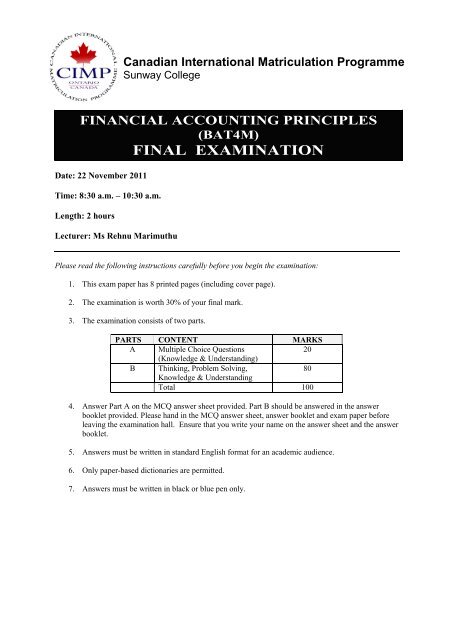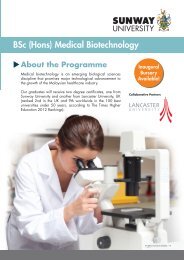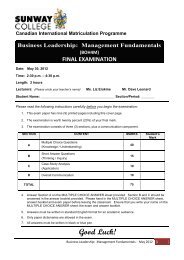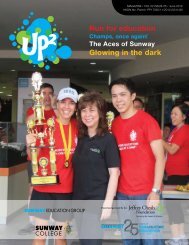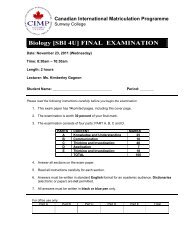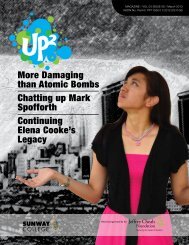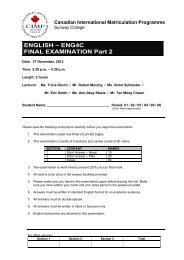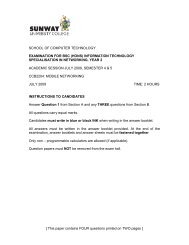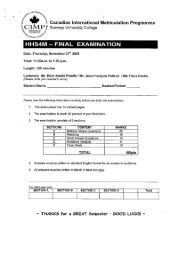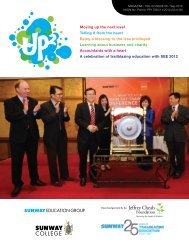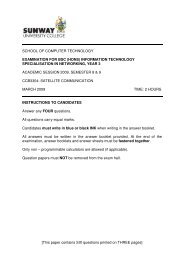Question Booklet - Sunway College
Question Booklet - Sunway College
Question Booklet - Sunway College
You also want an ePaper? Increase the reach of your titles
YUMPU automatically turns print PDFs into web optimized ePapers that Google loves.
Canadian International Matriculation Programme<br />
<strong>Sunway</strong> <strong>College</strong><br />
FINANCIAL ACCOUNTING PRINCIPLES<br />
(BAT4M)<br />
FINAL EXAMINATION<br />
Date: 22 November 2011<br />
Time: 8:30 a.m. – 10:30 a.m.<br />
Length: 2 hours<br />
Lecturer: Ms Rehnu Marimuthu<br />
Please read the following instructions carefully before you begin the examination:<br />
1. This exam paper has 8 printed pages (including cover page).<br />
2. The examination is worth 30% of your final mark.<br />
3. The examination consists of two parts.<br />
PARTS CONTENT MARKS<br />
A Multiple Choice <strong>Question</strong>s<br />
20<br />
(Knowledge & Understanding)<br />
B Thinking, Problem Solving,<br />
80<br />
Knowledge & Understanding<br />
Total 100<br />
4. Answer Part A on the MCQ answer sheet provided. Part B should be answered in the answer<br />
booklet provided. Please hand in the MCQ answer sheet, answer booklet and exam paper before<br />
leaving the examination hall. Ensure that you write your name on the answer sheet and the answer<br />
booklet.<br />
5. Answers must be written in standard English format for an academic audience.<br />
6. Only paper-based dictionaries are permitted.<br />
7. Answers must be written in black or blue pen only.
PART A: MULTIPLE CHOICE QUESTIONS (K/U)<br />
-----------------------------------<br />
Please shade the correct answer on the answer sheet provided.<br />
(20 Marks)
-----Page 4<br />
PART B: THINKING, PROBLEM SOLVING, KNOWLEDGE & UNDERSTANDING<br />
-----------------------------------<br />
<strong>Question</strong> 1<br />
Basem operates Sweetie Boy Company. The trial balance of Sweetie Boy Company has the<br />
following accounts at its year-end, December 31, 2009:<br />
($)<br />
Accounts Payable 48,500<br />
Accounts Receivable 32,350<br />
Accumulated Depreciation – Building 23,600<br />
Accumulated Depreciation – Office Equipment 11,000<br />
Advertising Expense 15,930<br />
Allowance for Doubtful Accounts 350<br />
Bank 25,500<br />
Basem, Capital 113,000<br />
Basem, Drawings 9,000<br />
Building 102,640<br />
Interest Expense 5,880<br />
Interest Revenue 7,056<br />
Merchandise Inventory 17,100<br />
Office Equipment 71,640<br />
Prepaid Insurance 5,700<br />
Purchases 428,820<br />
Purchase Discounts 15,700<br />
Purchase Returns and Allowances 12,300<br />
Salaries Expense 43,200<br />
Sales 542,194<br />
Sales Discounts 2,500<br />
Sales Returns and Allowances 7,190<br />
Utilities Expense 6,250<br />
Adjusting data:<br />
1. The annual depreciation is $1,740 on the building and $4,400 on the office equipment.<br />
2. Insurance policy is for 1 year, dated October 1, 2009.<br />
3. Salaries of $1,840 are accrued at December 31, 2009.<br />
4. Sweetie Boy Company estimates its bad debts expense to be 4% of accounts<br />
receivable.
-----Page 5<br />
Other additional information:<br />
1. Merchandise inventory on December 31, 2009, is $22,220.<br />
2. Salaries expense is 50% selling and 50% administrative.<br />
3. Insurance expense is 60% selling and 40% administrative.<br />
4. Depreciation on building, depreciation on office equipment and utilities expense are<br />
administrative expenses.<br />
5. Advertising expense is a selling expense.<br />
6. Sweetie Boy Company uses a periodic inventory system.<br />
Instructions:<br />
a) Prepare the adjusting entries for the ended 31 December 2009. (Narration not<br />
required).<br />
(5 marks)<br />
b) Prepare the multiple-step income statement and owner equity’s statement for the year<br />
ended 31 December 2009 and a classified balance sheet as at 31 December 2009.<br />
(29 marks)<br />
<strong>Question</strong> 2<br />
On December 1, the accounts receivable control account balance in the general ledger of the<br />
Bernard Dental Store was $9,000. The accounts receivable subsidiary ledger contained the<br />
following detailed customer balances: Sakib $1,500, Ting $2,100, Hutomo $2,600, and Jeet<br />
$2,800. The following information is available from the company's special journals for the<br />
month of December:<br />
Cash Receipts Journal: Cash received from Hutomo $1,900, from Sakib $1,600, from Sung<br />
$1,700, and from Ting $1,800.<br />
Sales Journal: Sales to Sung $4,300, to Hutomo $1,700, to Sakib $2,300, and to Jeet $2,400.<br />
Additionally, Hutomo returned defective merchandise for credit for $900. Sakib returned<br />
defective merchandise for $600 which he had purchased for cash.<br />
Instructions:<br />
a) Post the above transactions to the appropriate control and subsidiary ledgers.<br />
(10 marks)<br />
b) Determine whether the subsidiary ledgers agree with the control account.<br />
c) List down two advantages of subsidiary ledgers.<br />
(4 marks)<br />
(1 marks)
-----Page 6<br />
<strong>Question</strong> 3<br />
Baby Yang Corporation’s fiscal year is on 31 August. In 2008, Baby Yang Corporation sold<br />
three of its assets and the information concerning the assets is summarized below:<br />
Asset Cost Purchase<br />
Date<br />
Useful<br />
Life<br />
Salvage<br />
Value<br />
Depreciation<br />
Method<br />
Disposal<br />
Date<br />
Disposal<br />
Amount<br />
Equipment $150,000 1/6/2005 5 $25,000 Straight line 31/5/2008 $55,000<br />
Delivery $120,000 1/5/2006 6 $6,500 Units-ofactivity<br />
31/5/2008 $38,000<br />
Truck<br />
Machinery $120,000 1/7/2006 8 $10,000 Declining<br />
balance<br />
30/11/2007 $100,000<br />
For the declining balance method, the company uses the double-declining rate. For the unitsof-activity<br />
method, total miles are expected to be 500,000. Actual miles of use in the first<br />
three years were: 2006: 25,000; 2007: 145,000; and 2008: 105,000.<br />
Instructions:<br />
a) Compute the amount of depreciation expense for the three assets above for each year<br />
to the date of disposal using the given method. (All answers rounded to nearest<br />
dollar).<br />
(8 marks)<br />
b) Prepare the adjusting entries for depreciation for 2008 and the journal entries for the<br />
sale of each asset.<br />
(9 marks)
-----Page 7<br />
<strong>Question</strong> 4<br />
The stockholders’ equity accounts of Cherris Corporation on January 1, 2008, were as<br />
follows:<br />
Common Stock, $5 par value, 500,000 shares<br />
authorized, 200,000 shares issued<br />
and outstanding $1,000,000<br />
Paid-in Capital in Excess of Par Value 200,000<br />
Retained Earnings 840,000<br />
During the year, the following transactions occurred:<br />
January 15 Issued 3,000 shares of common stock for $25,500.<br />
17 Declared a $1 cash dividend per share to stockholders of<br />
record on January 31, payable February 15.<br />
February 15 Paid the dividend declared in January.<br />
April 15 Declared a 10% stock dividend to stockholders of record on<br />
April 30, distributable May 15. On April 15, the market<br />
price of the stock was $15 per share.<br />
May 15 Issued the shares for the stock dividend.<br />
July 1 Announced a 2-for-1 stock split. The market price per share<br />
prior to the announcement was $17.<br />
20 Purchased 15,000 shares of common treasury stock at $8 per share.<br />
September 3 Sold 4,000 shares of treasury stock – common for $36,000.<br />
December 1 Declared a $0.50 per share cash dividend to stockholders of<br />
record on December 15, payable January 10, 2009.<br />
31 Determined the net income for the year was $350,000.<br />
Instructions:<br />
a) Journalize the above transactions.<br />
b) List down one advantage and one disadvantage of a corporation.<br />
(13 marks)<br />
(1 marks)


